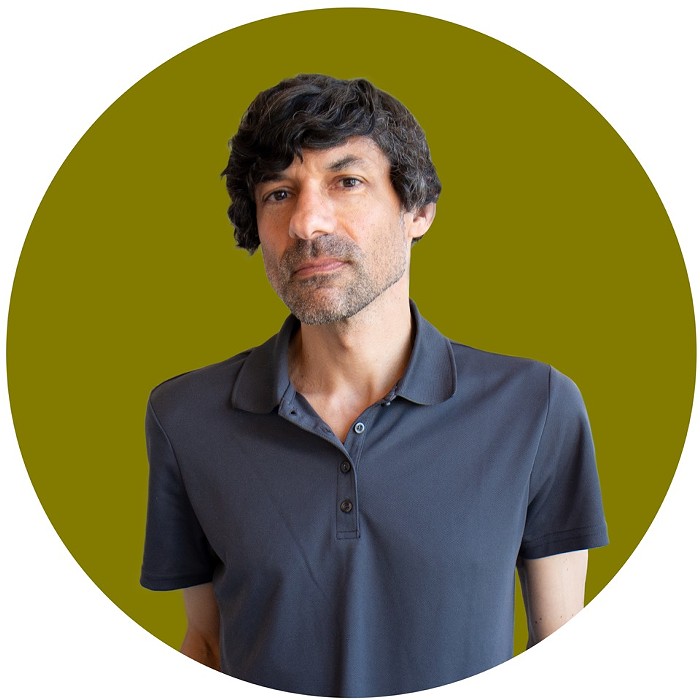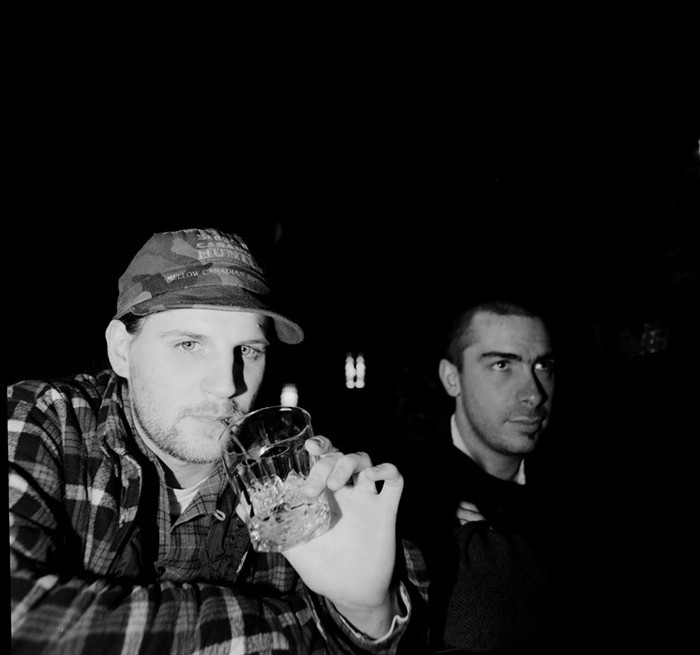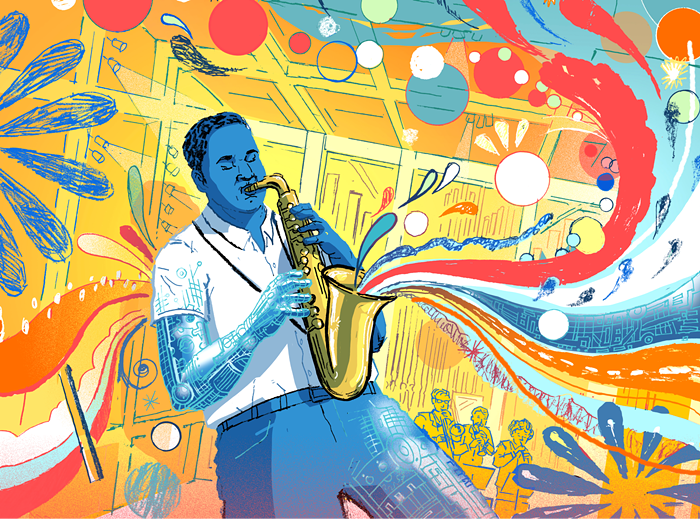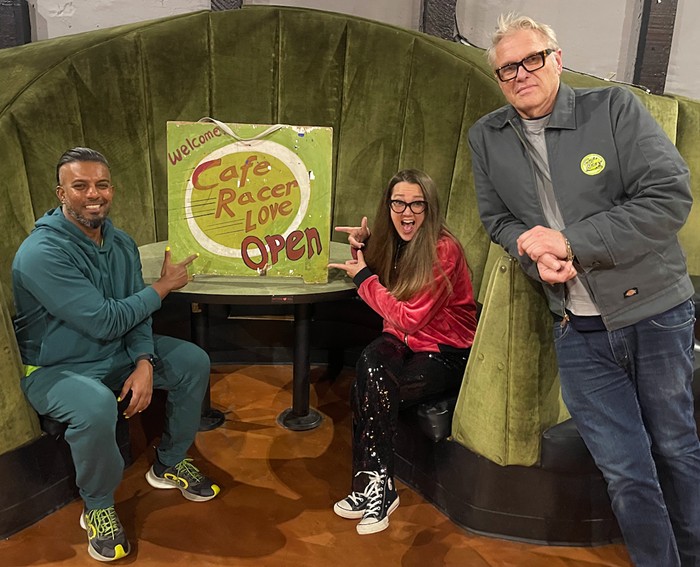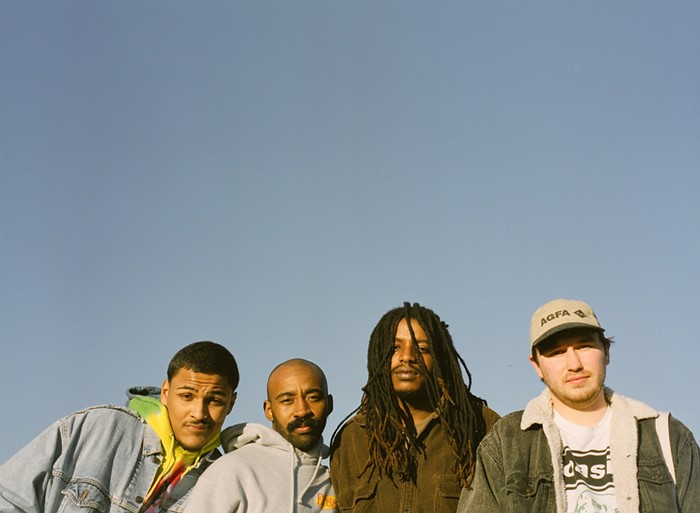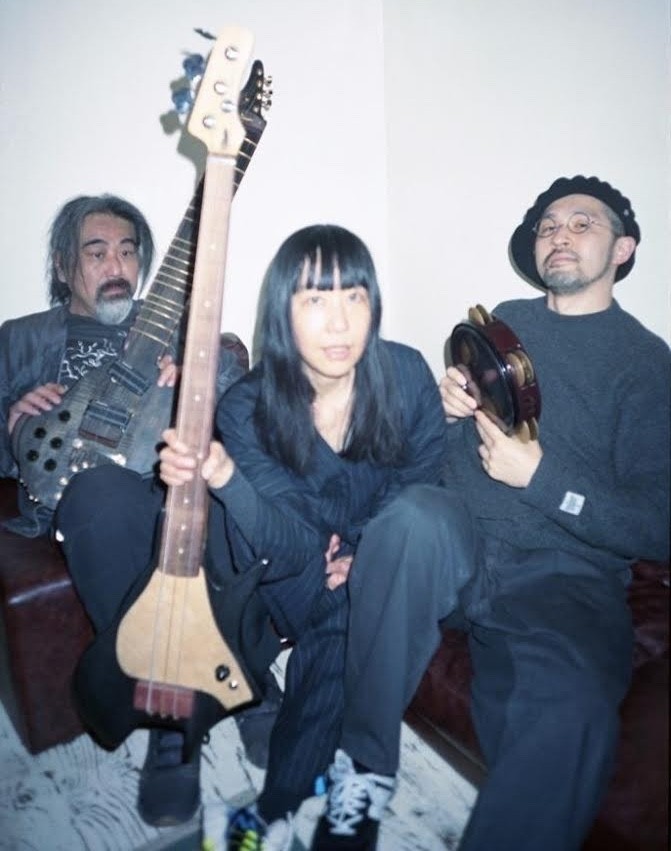If jazz is to avoid becoming a museum piece strictly for the over-50 set, it's going to need to mutate and evolve. There are touring acts out there that are doing this (Kamasi Washington, BADBADNOTGOOD, and the Bad Plus come to mind), and there are hometown heroes Industrial Revelation, who are masters of thrilling stylistic fusions (and winners of a 2014 Stranger Genius Award). But in the last five years or so, Seattle has witnessed an upsurge in musicians who are doing very interesting, adventurous things in what we will loosely call the jazz realm and who are converting non–jazz heads into faithful followers.
Bad Luck, a duo that's performing at the Earshot Jazz Festival in October, have made giant strides into the consciousness of Seattle's experimental-music scenesters this year, with jaw-dropping performances at Decibel Fest and at a Hollow Earth Radio show opening for Baltimore trance rockers Horse Lords. Consisting of saxophonist/loop manipulator Neil Welch and drummer Chris Icasiano, Bad Luck have been winning over legions of fans who wouldn't know Ken Burns or Wynton Marsalis if they were shaking hands with them.
Icasiano admits that jazz musicians have an obstacle to getting heard at a time when the music's rarely been less commercially viable. "To many people, jazz is a four-letter-word. There are quite a few negative stereotypes about jazz that characterize the music as self-indulgent, complicated, and boring to the greater listening audience, especially [among young people]. In many instances, this stereotype is true, which is why the music can be perceived as utterly inaccessible and alienating. So our challenge, as a band that's trying to bridge the gap, is to dispel this stereotype."
No matter what you'd label them, your senses would have to be pretty numb not to be awed by Bad Luck's music. It bears down on you like a cyclone of fire, recalling some of the more out-there excursions of John Coltrane, Albert Ayler, and Peter Brötzmann. Icasiano's drumming harnesses shocking power and does strange things to your perception of time and space. He can also get oblongly funky when the urge hits. Welch is a dynamo of galvanic spluttering, ecstatic shrieks, and placid drones. Most of the time, you have no idea where Bad Luck are going, but they impel you to follow closely, no matter what.
Another of the relatively new local groups working in this vein is Afrocop, a trio that almost sounds like Industrial Revelation's introverted and more psychedelically inclined cousin. Afrocop are too mercurial to stay confined to a single category. Drummer Andy Sells told me: "We draw as much from punk and electronic music, gospel, afrobeat, funk, soul, psych as we do from jazz."
That Afrocop got asked to play Northwest Psych Fest back in August while also holding a monthly residency at a traditional jazz venue like Vito's speaks to their unusual versatility. Their August 12 festival set at the Sunset Tavern offered a sweet balance between the earthy and the ethereal, as well as the funky and the cosmic; they gracefully strutted through rock, funk, and jazz modes. "We make people feel psychedelic," keyboardist Noel Brass Jr. said after one long, serpentine piece at that show. His kaleidoscopic tone poetry ranged from beatific to strident, touching on the crucial work of Chick Corea and Keith Jarrett during their Miles Davis tenures, John Medeski, and Wolfgang Dauner.
With Sells on drums and Carlos Tulloss on bass and baritone guitar (experimental guitarist Bill Horist sometimes joins them live), Afrocop are essentially an improvising jam band that play with fervid imagination and tensile dynamics. After their Northwest Psych Fest performance, Brass told me, "You know how Elvis Costello spins that song wheel [during his concerts]? We sort of do that with tones."
Sells claims that Afrocop shouldn't really be classified as jazz "because we don't deal with song form, the blues, or really any of the conventions of what would be considered traditional jazz. The only two things I could point to as being like jazz are the improvisational aspect and our chops as players. I play a lot of patterns influenced by the greats I came up on, such as Max Roach, Tony Williams, Jack DeJohnette, Art Blakey, and so on. But I also draw a fair amount from being an '80s hiphop kid listening to breakbeats and drum machines."
Sells does admit that Afrocop seek inspiration from jazz's liberating improvisational element, that exhilarating sense of creating in the moment. Being categorized as jazz, though, is a double-edged sword. It can land Afrocop regular gigs, but it can also repel potential listeners who have a reflexive bias against the term.
Afrocop's members are well aware of the challenges that contemporary bands who identify as "jazz" face with regard to gaining media exposure, better gigs, and airplay. Tulloss, the guitarist, says, "Most of the music that sells commercially is dished out in perfect packets of emotional candy, like a Cinnabon. It's formulaic and predictable and it gets you that fix you need. Afrocop is an experiment of exploring the abstract, inner spaces of the mind. We go in with no plan and we look for those invisible terrains that we are all exploring, and we chart that space with notes... Sometimes that terrain is sweet like Cinnabon, and sometimes it tastes like farts. But the practice of working through those spaces and getting reflective with yourself via music is important and lacking in this society."
Another unit altering Seattle's jazz terrain is the quartet Chemical Clock. Keyboardist Cameron Sharif acknowledges a love for piano immortals like Bill Evans, Thelonious Monk, and Herbie Hancock, but his band avoids overly reverent homages to them. Chemical Clock's music also carries elements of math rock, disco, hiphop, and EDM, Sharif observes. "Some of my favorite music is drawing upon a wide array of sounds and influences and finds a way to synthesize it," he says. "That assimilation of ideas is a part of jazz's history, so that's where the influence must be. I've definitely been influenced by this exploratory nature of jazz, which in turn makes it hard to pin down. And this exploratory nature can be found at any stage in jazz's history, not just the later, post-fusion era. For instance, my favorite recordings from the swing era are chock-full of surprises. There is an energy of spontaneity there which makes it feel like anything can happen."
Because everyone conceives of the word "jazz" differently, it's unproductive and perhaps perilous for a group to identify as such, Sharif says. "The word doesn't really say anything about the music to whoever might be interested in it. It seems like most young listeners who didn't already grow up either listening to or playing jazz aren't very interested in jazz. So it's a bit limiting. I would be more likely to try to describe the music as a sort of fusion of styles that they can relate to than just call it jazz."
Whatever you want to call Chemical Clock's music, it will stun you with its energy and inventiveness. They made an amazing first impression on me last May at the Sunset Tavern, where keyboardist Sharif, trumpeter Raymond Larsen, drummer Evan Woodie, and bassist Mark Hunter ran through six songs of flamboyant jazz fusion and rhythmically unconventional funk. Touchstones included Miles Davis's turbulent '70s electric period, the strangest facets of Weather Report, Ornette Coleman's harmolodic totem Of Human Feelings, and iconoclastic, eccentric composer Henry Threadgill. But Chemical Clock weren't imitating these fusion legends and avant-garde pioneers; they were just drawing inspiration from them while balletically sojourning into their own contorted sonic back alleys.
Having a tangential relationship with jazz hasn't hindered the progress of the fourth act I want to tell you about, Hound Dog Taylor's Hand (named after the late Chicago blues guitarist's six-fingered left hand); if anything, it's helped them to shred the decorum of jazz niceties. The band relies largely on "improvisation, swing, and the harmonic and melodic context of the blues." Speaking as a collective, they say, "The blues in jazz is fundamental, yet it is not sacred. As the blues by definition can never be sacred, so must jazz be free of dogma even as it develops spirituality."
These veterans of Seattle's avant-garde-jazz and underground-rock scenes— guitarist Jeffery Taylor (Climax Golden Twins/Spider Trio), bassist John Seman (Ask the Ages), and drummer Mark Ostrowski (Wally Shoup Quartet)—may be the group here most at odds with conventional notions of jazz. "Our role as present-day spontaneous composers in the idiom of improvised music is to honor as well as challenge the foundational understanding of music, its social and political context, and its expectations and implications. The three of us are voracious listeners with wide-ranging tastes, and by that virtue, certain inflections are bound to creep in. We are distilling our influences and knowledge of various music into real-time improvisations. Paramount to playing freely improvised music is close listening and reaction to what each instrument is doing individually. This is a central tenet to jazz, whether composed or freely improvised. Mostly, though, we just like to rock the fuck out."
Like many Seattleites who make adventurous music, HDTH lament the loss of the city's "underground crevices and backdoor corridors. This has wrought calcification at traditional jazz outlets, where the far-out and unexpected is unwelcome and rock clubs don't want to hear that you are a 'free-jazz' or 'improvising' band. That shit doesn't sell drinks."
At their best, though, HDTH make getting drunk redundant. Their music—an artful conflagration of noise rock and free jazz, hinting at the explosive power and jagged dynamics of guitarsonists Sonny Sharrock and James Blood Ulmer and the high-flying fusion of Mahavishnu Orchestra drummer Billy Cobham's Spectrum—will more than help you get out of your quotidian mindset. HDTH's new self-titled album (out November 11 on Abduction Records) isn't all pyrotechnics, however. It occasionally veers into moments of tender meditativeness, as exemplified by "Relax, It's Okay" a companion piece with the Jimi Hendrix Experience's "Castles Made of Sand." For those who are ready to embrace dissonance and scrupulously modulated chaos, this record's going to turn heads and blow minds.

